TECHNOLOGY in communication, entertainment & information
Perhaps my earliest awareness of technology developing was when plastic toys no longer broke almost as son as we got them. Almost all of those had "Hong Kong" embossed on them. I was amazed to see plastic tricyles at the annual Round Table Hobbies Exhibition. And various precursors of more modern communications and entertainment systems.
Telegrammes
A popular method of communication over great distances was with telegrammes. The story of the telegram begins with the visionary mind of Samuel Morse, who in 1844 sat at a telegraph machine in Washington, D.C. and tapped out the now-famous words, "What hath God wrought?" This simple message, transmitted instantly through copper wires to Baltimore, marked a revolutionary breakthrough in human communication. Morse‘s invention of the telegraph, and the subsequent development of the Morse code, would forever change the way information was shared across vast distances. [HIstorytools.com]. This is how important information was sent over long distances when I growing up. The long distance phone call we well established, but this co-existed as it offered an "almost" instant tangible, what generations later would term, a hard copy. A degree of formality.
One would go off to the Post Office with the message written out and the operator there would type it in. It would be sent almost anywhere using the cable system, which included undsersea cables linking continents. The message would then be physically delivered to the recipient by hand, in an envelope or simply folded over, such as by a postman. Of course the message was seen by the operators at both ends denying full confidentiality.
An example is given under CRAWFORD, ANNIE, nee Cherry who received a celebratory telepgramme from the Queen for reaching 100.
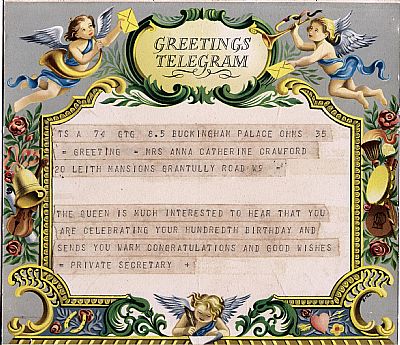
We have this framed telegramme. Note the glued on paper strips with the message. The receiving post office would have mounted them on the special card.
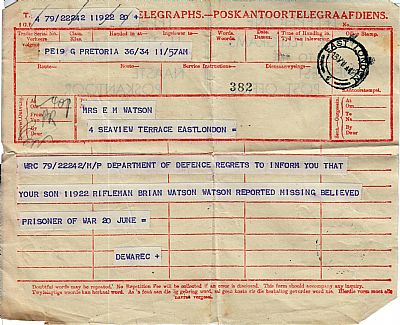
My grandmother Maud received this disturbing telegramme about her son Brian Watson. He had in fact escaped not only direct conflict, but capture too. That is discusse here WATSON, BRIAN AT WAR. The sending office is Pretoria and the receiving office is date stamped East London. The receiving operator's initials appear in pencil on the side.
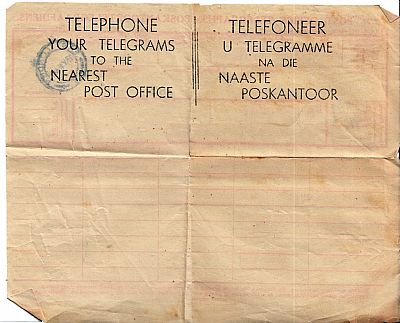
The reverse shows how it was simply folded over. This one advertises the ability to simply send in a message over the phone and let the post office do the rest.
Today "telegram" is a Telegram is something quite different, a cloud-based mobile and desktop messaging app.
Telex
When I was in the navy at Maritime Headquarters in Youngsfield, we had a telex machine. Telex is a telecommunication system that allows text-based messages to be sent and received by teleprinter over telephone lines. The term "telex" may refer to the service, the network, the devices, or a message sent using these. Telex emerged in the 1930s and became a major method of sending text messages electronically between businesses in the post-World WarII period. Its usage declined as the fax machine grew in popularity in the 1980s. ..... The technology operates on switched station-to-station basis with teleprinter devices at the receiving and sending locations. It operates over the circuits of the public switched telephone network or by private lines. ... To reduce connecting line usage, telex messages were encoded onto paper tape and then read into the line as quickly as possible.[Wiki].

Google image. Note the main type printer and the narrow paper strip alongside it. Contact was made with the standard dial of the time. We would have lengths of tape curling onto the floor. Some of those more experienced could read the dots, much like Morse Code. And others somehow managed to get images onto the text sheets using only letters and numerals. Marilyn Munroe for instance.
Telephones & communications
Elsewhere I mention trunk phone calls to Aunt Daisy in London. These were booked ahead and we all had turns to speak, each sentence needing a few seconds to get through and be answered. This was of course all done via undersea cables - satelites still in the future.
Country districts had share lines for several farms or homes. One had to use a simple code such as 2 or 3 rings from the switch board to know who had to answer. Naturally this caused some confusion sometimes and eavesdropping. My mother's friends down near Chalumna River would often suspect eaves dropping and to test it talk funny or make a joke to get a reaction. Or she would say something like "Oh, I am pregnant again". She was beyond middle age at that time and everyone knew each other in the district.
As a pre-teen I had my personal museum in the basement of our Nahoon house : shells, a wooden net mending needle found when the Orient Beach Theatre and complex was being excavated. And the handset of an antique windup phone. This was donated by one of my maternal grandmothers bridge playing friends (not an heirloom).
This reminds me of the days pre-mobile / cell-phone when you needed to find a public phone if you were out and about and needed to call someone. That of course was to be found in a telephone box. SA had a few red boxes from the UK, but more common was the African-ised version, a tall rondavel sort of box, painted cream with a red shallow conical roof. When such service began to disappear (still long before mobiles) they could sometimes be found on private property; they had become memorabilia. Their demise was in most cases to do with upkeep and vandalism. General misuse and theft of the small change in the box. Most smelt of urine. Few had their chunky phone directory books still dangling from their robust chains. Many ceased to work.
We stil have quite a few in the UK. There is a legal obligation on the service providers to keep them working. This is usually to do with accident black spots or areas with poor mobile signal, but many others are simply kept for what they signify.
My father belonged to the Round Table and each year we went to the Hobbies Exhibition in the wool warehouses down town. At least to my young eyes this was an enormous event - not just hobbies, but many trade exhibitions, society displays, even a temporary ice rink with a show. I remember seeing video for the first time, operated somehow off an LP record. But the first time I saw TV was the closed circuit one that sort of worked on the ship I was on in the navy.
Looking back at our office is interesting too. See TECHNOLOGY in architecture I describe our fax machine there, but our phones are also of note. We had a small switch board on the reception counter. Each of us had a phone. These had dials back then, push buttons still becoming popular.
"CB" or citizen band radios were common for farm communications but restricted by the government for general use as they could interfere with emergency service radio contact. Remember that this was way before mobile / smart phones. In time they became less restricted.
Once when still a student in Port Elizabeth I was driving down the esplanade with the radio on when a car came alongside at the lights. The voice on the radio was of someone talking to his mother about what he wanted for supper. I realised that he was on a CB car radio and his voice had overlapped with that of the programme I was listening to. This was probably excepotional as he was so close, but it did show how it could interfere.
Radio mics were becoming popular on live shows. I remember one with Sandy Shaw with Leapy Lee in East London when the taxis drivers came accross the show's loud speakers.
Another possible reason for the restrictions on CB radios for so long was the Red Threat, ie communist infiltration and revolt. An almost blanket ban on such radios was thought to reduce the possibility of planning anything.
Car phones were a natural progression from this and became available about this time, but were not common.
I write under POLITICS & SECURITY about my peripheral involvement in politics and in chairing the local branch of the South African Institute of Race Relations. It was about this time that people that I was in contact felt that their phone calls were being tapped and, perhaps somewhat nervously, suspected that ours was too. Quite how one could tell is hard to put ones finger on. A few years later we did some workshops for the Ciskei Government. Initially this was still paid for and controlled from Pretoria so we met SA national Department of Public Works officials. One casually said that his department had been used as a front by the Security Police to tap suspect phone calls around the country.
When we moved our architectural office to new premises in Devereux Avenue in Vincent, my father went into a partnership with a builder and the next door garage proprietor. That became "Treble B". The result was our offices on the top floor and some shops on the ground floor. The builder used one and the others were let out. For a while Vodacom leased one, but quickly moved into the new larger Vincent Shopping Centre.
This was the era when a mobile / cell phone could be about the same size as a brick. Yes really. The size was cumbersome by todays standards, but it was also flashy! We didn't get tempted.
Watch older movies and you may see one. James Bond was probably the first to talk through his watch or cufflinks, but the realities took a while to really become feasible. There was some excitement when a James Bond phone became available on the market. Remember the one that combined a calculator with a phone? It came in a snaz oval fold-open case. Oh wow!
Cell phones began to get a bit smaller. But they were still a bit of a gimmick. Drinks and food orders were being made accross pubs and restaurants by phone - to the irritation of the staff.
By the time we had emmigrated to Scotland they were more recognisable as mobile phones - small enough for a handbag or pocket. I spent one of my first pay packets on getting the family one each. Open faced, then flip phones or sliding face.
The international network was growing apace. I sorted some of my last South African financial policies by phone while standing in Kelvingrove Park during lunch breaks.
Smart phones now do almost anything. Their impact on social behaviour, on each and everyone one of us, is phenomenal. Watch a crowd anywhere at any time and most will be doing something with their phone.
From radios to Spotify
My father's mother Maud told me of how they could make their own sound recordings. Cylinders of a hard waxy material could be bought specifically for this. One then spoke or sang into the horn while it rotated and this produced a continuous profiled groove against which a needle could be laid when played back. While the shape would have been very different, this was in fact very similar in principle to the discs that were also available at the time and the records that came later. Wiki tells us: Beginning in 1889, prerecorded wax cylinders were marketed. These have professionally made recordings of songs, instrumental music or humorous monologues in their grooves.....Cylinder machines of the late 1880s and the 1890s were usually sold with recording attachments. The ability to record as well as play back sound was an advantage of cylinder phonographs over the competition from cheaper disc record phonographs, which began to be mass-marketed at the end of the 1890s, as the disc system machines could be used only to play back prerecorded sound [Wiki]. 
An example from Wiki
I have inherited a small record. It is a little smaller than a 7-single and is alluminium. It appears to have been a souvenir demo one from an exhibition in the UK and was made for my maternal grandmother and a sister. It needs a wooden needle to be played. A metal one would destroy the surface. Not having a wooden needle I have tried a rose thorn on the turntable. I can't make out the voices, but you can hear perhaps two young women talking and laughing. The rest seems to be promotional blurb.

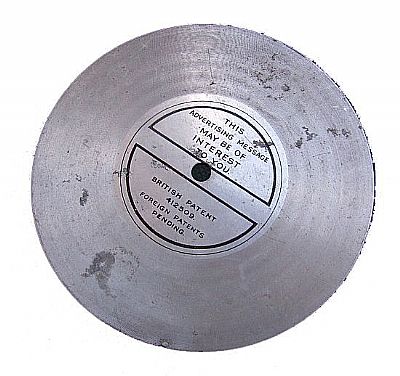
The two sides of the same small record. The labels say:
USE ONLY WOODEN NEEDLES
VOICE RECORDS LIMITED (with logo)
DUPLICATE OF THIS RECORD OR LARGER RECORDS WITH ACCOMPANIMENT
CAN BE MADE AT OUR HEAD OFFICE
56, MOORGATE, LONDON
and on the other
THIS ADVERTISING MESSAGE MAY BE OF INTEREST TO YOU
BRITISH PATENT
412509
FOREIGN PATENTS PENDING
My father bought a radiogram in the 60's. In British English, a radiogram is a piece of furniture that combined a radio and a record player. The word "radiogram" is a portmanteau of radio and gramophone. The corresponding term in American English is console. [Wiki]. It operated with "valves" much like light bulbs and these grew very very hot. Opening up the back to check them was a risky business. He used to play the most attrocious LPs (by our tastes), but I did like some of the LPs we got through our LP mail order club. It was a stereo player and I heard this newish audio technology for the first time on it - music that featured a steam train that seemed to travel around the room. The radiogram as a unit though was quite smart. Fabric covered speakers each side. The radio which included FM, short and medium wave options had turn dials for band selection and volume. My father spent many hours fiddling with it to find interesting stations and even the beep beep beep of passing satelites. A fold-down door opened the gramaphone / record player and there was some space below that in a shallow shelf for LPs. On top my mother placed a vase with flower etc.

Something like this one (Google image).
As valve radio development ended in the late 1960s and transistors began to take over, radiograms started to become obsolete. By the late 1970s, they had been replaced by more compact equipment, such as the hi-fi and the music centre [Wiki]. The record player would slide forward. Records would be stored to one side. The speakers were covered in a fancy fabric (not with doors as here. The dial had Short Wave, Medium Wave and even FM (Frequency Modulated), although invented in 1933, the manufacturers boasted about it on new sets (basic radios) didn't have it).

Typical valves. Pic from Google.
Size and science though meant that the transistor soon followed. That led to portable radios. At one extreme were the bulky ghetto blaster radios taken to parties and picnics. In the middle were more recognisable transistor radios. But at the smaller end were very small transistor radios that could be carried in our pockets. Earphones came in about now and ensured a reasonable sound quality, the main speakers being somewhat tinny. As kids we would ride around the neighbourhood with music, well not exactly blaring, but certainly audible. We used to shock the maids chatting on the pavements with music coming mysteriously from somewhere secret in our clothes. They may have been rather naive about such technical developments then, but perhaps we were too with them simply being patronising.
I was never one to really get excited about the latest hits although I did enjoy them on the radio. I had a few 7-singles and began to collect LPs; my first one being one of Led Zeppelin's that I bought with my navy discharge pay.
Between us we have built up quite a collection of LPs and also the early 78s and still have most of them.
When at primary school someone brought it his fathers tape recorder - a large box of a thing with two reels. It created quite a stir. By the time I was a student tape cassettes were all the vogue and available in cars. You could even get a type with 8 tracks. We could save money on records by taping off the radio. The tapes themselves would inevitably jam and many a time needed rewinding using a pencil in the little cog wheel. If they really got completely jammed or damaged they were discarded. Having them in cars meant that many a tape ended up glittering in the trees along country roads.
When CDs came it was an exciting breakthrough. And we could now also have those in our cars. At first the CD would jump if we went over a bump, but that was eventually sorted. CDs still meant that you could buy a complete album and they came with attractive boxes complete with printed details of the band etc.
By the time that MP3 players came all the visual side, the tangible aspects of collections disappeared. We, my wife and I, never went down that route, but our daughters did and missed out on those aspects. Of course alongside this came CD-ROMS and the ability to both store data on them and burn one's own "CDs".
Spotify, amongst others, came out in 2006. It took me all the way into 2025 to begin using it and this was because I needed to get a newer car and that came with a proper screen for Sat-Nav etc. I still prefer live radio, but listen to Spotify on weekends when the stations are full of naf music and sport.
A box of nik naks
My father had inherited some niknaks from a family member that had probably been a cousin. The box contained items from a hobby that included a small steam engine, a barometer and a crystal set. Unfortunately these were all just bits so we couldn't try them out and they were discarded.
You can now buy crystal sets. (Try Amazon). Back then they would have been made from scrap and possibly formed school projects. There is a link to pdf instructions below. A crystal radio receiver, also called a crystal set, is a simple radio receiver, popular in the early days of radio. It uses only the power of the received radio signal to produce sound, needing no external power. It is named for its most important component, a crystal detector, originally made from a piece of crystalline mineral such as galena This component is now called a diode. [Wiki].
I never had my own, but did see those others had built. Extraordinary to think of these signals in the air all around us. At that time shortwave radio was still common, only later becoming medium wave with FM (frequency modulated) becoming the norm later. FM had been invented back in 1933 and it enabled high-fidelity sound, but it was heralded late in South Africa in part at least due to the sparseness of the population across much of the country. There were technical and cost difficulties in getting the coverage then (much as there has subsequently been with cell-phone / mobile coverage).
Super 8 & rented movies
Every self respecting guy had a super-8 camera. For some reason women did not get into it as much. Perhaps it was something to do with "having a hobby to tinker with". The 8 refers to the film width in mm. Most families seem to have reels of film of young children running around, over exposed frames often blotting out any clarity.
Arranging children's parties was always a challenge after some silly games, cake and obligatory goody bags, mainly of sweets, so film, usually 16mm, and a projector were rented. Such equipment was usually rather suspect and there were endless delays setting up. Films were almost always black and white such as Laurel and Hardy, but we also saw some colour documentaries including the tear jerking docu-drama Bambi from Disney. A popular moment was when the film was shown backwards.
Even at university we rented movies, but which could be considered "proper" films. There was for a while even a movie club and somehow we managed to get film director John Boorman to speak to us. He was travelling the country promoting his movies.
Our architecture department also had movies on a social basis and I learnt to run the projector, how to splice film that had snapped from becoming brittle using sticky tape or even staples. If you had a pile of coiling film pieces come out of the can, it was possible that they got reconnected in the wrong order. Watching the result could be confusing.
We also had to respond quickly if the film caught fire, which it was prone to do if it jammed against the very hot projector bulb. This was usually caused by the perforations that ran over the cog ratchets breaking off and the film slipping. The first hint was a growing blodgy mark visible on the screen followed by a whiff of smoke. This could happen in cinemas too with their larger film format and even stronger light beams.
Even with TV available years later, film clubs were popular with the benefit of getting to see films that were not usually available on the regular film circuit. I have memories of seeing some in halls with little impatient kids eventually falling asleep, ours at that time still in a carry cot.
One such venue actually had a proper projection room with proper old projectors gleaned from a cinema that had closed down. These were already old and only one equally ancient Chinaman could operate them. They used burning carbon rods to get the very strong projection light. We were always nervous of them catching fire.
The method of recording and playing the sound track presisted from very early on. This was printed onto the film itself and you could actually see it. Yet it would give excellent sound reproduction as long as the speakers were of equal quality.
The standard film format (which is still used) is 35mm. The cinema's speaker systems improved even more with Sensurroound adding impact and realism. Today we have IMAX to add scale and the sense of immersion, but back in the late '60s Cinerama arrived. This had evidently been invented very early on, but only came available then. I saw it in Cape Town. The system involves a curved screen and three separate projectors in sync. Those sitting towards the front are almost surrounded by the moving image. The further back one sat the less the impact, it fact it became almost pointless. Just imagine the process of also filming with 3 cameras and the issues of production and then projection needing perfect synchonisation.
Television
While kids in the UK and elsewhere were enjoying iconic childrens stories on TV and teenagers were enjoying pop videos and the latest hits, South African children did not.
TV in South Africa had been banned by the government. The prime minister, Hendrik Verwoerd is reputed to have likened television with destructive elements such as poison gas and atomic bombs, stating:
‘…they are modern things, but that does not mean they are desirable. The government has to watch for any dangers to the people, both spiritual and physical.’ [Hirsh's blog].
Wikipedia adds : Dr. Albert Hertzog, the Minister for Posts and Telegraphs at the time, argued that "the effect of wrong pictures on children, the less developed, and other races can be destructive." Declaring that television would come to South Africa "over [his] dead body," Hertzog denounced it as "only a miniature bioscope which is being carried into the house and over which parents have no control." He also claimed that "South Africa would have to import films showing race mixing, and advertising would make Africans dissatisfied with their lot." [Wiki].
Another escuse was the cost of setting up a nation-wide infrastructure. This was true, but you need to see this in the context of a perceived need to have full control. In other words we needed to produce all our own content.
TV did eventually come. Ironically this was in 1976 – the same year as the Soweto uprising. I was at university and used to go across to the Elizabeth Hotel over the road to watch such shows as Rich Man Poor Man and the World at War in the lounge with an Appletizer in hand. My boarding house digs run by the Starbuck family got a set and let us watch it, but their choice of content was certainly not mine.
Just consider that date for a moment. While the rest of the world was watching the firts men on the moon, we had to contend with a radio commentary and reading the Daily Dispatch in the morning. See MOON LANDING.
Actually I did get to see the first moonlanding. My mother took me to the cinema and we saw rush newsreels of it.
With a limited range of programmes, a morning start time and an evening stop time came the test pattern. You could tune in and adjust your set, but comparing the colour patterns. To make it a little more interesting, they sometimes showed viewers photos. One that I would have liked to have seen, but missed was of my father in his scouting uniform taken by someone at a scoutmaster and regional scouter forum.
I had been in the navy with technicians well trained in fitting and servicing radio, radar and sonar. Many of these seemed to attracted to the expanding aerial and tv fitting contractor companies.
The department stores naturally filled their large windows with TVs and left them on to attract customers. Not everyone could afford one straight away and it became common to see families "window shopping" and watching a sports match, news or soap drama standing there on the pavement. Some even came specially by taxi.
My father bought a tv which incorporated a good sized screen and a good loud speaker. Remember that screens then were chunky cathode ray tubes so were chunky, The whole elegant wooden fitting was about 1.2m high.
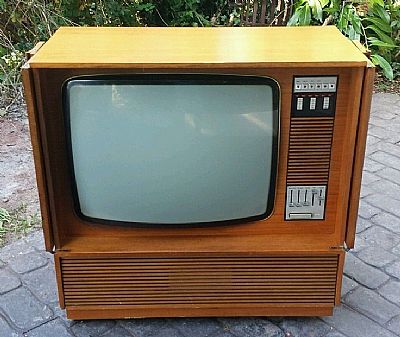
Ours was something like this. I don't remember it having fold-back doors though. This was about the largest screen available in the '70s. This unit included a good sound system with buttons to get exactly what you wanted. [Google image].
Note the curved grey screen. When you turned it off the picture would jump to a bright spot in the centre for a moment. When they first came out that spot could damage the screen so you had the option of leaving it on the test pattern between shows to limit the frequency of on and off - something very likely in a shop display. The test pattern became extremely boring and alternatives were created. The SABC showed short clips or pictures, but pretty much kept to its limited operating hours. So the screen saver was born, static images that made the TV look more attractive. Early computers had screens much along the same lines. And had the same tendency to get a mark in the middle from repeated turning on and off. But they took the screen saver to new lengths and ways were found to animate patterns in some extraordinary ways. We still see them today, even though we don't really need them anymore.
A cathode ray tube or CRT is a specialized vacuum tube in which images are produced when an electron beam strikes a phosphorescent surface. Television sets, computers, automated teller machines, video game machines, video cameras, monitors, oscilloscopes and radar displays all contain cathode-ray tubes. Phosphor screens using multiple beams of electrons have allowed CRTs to display millions of colors.The cathode ray tube (CRT) shot a concentrated beam of image at the screen and was spread out using elctro-magnets. [The Inventors website]. Readers of a younger generation take the term YOUTUBE for granted. That "tube" refers to the days when all displays were literally tubes. Big heavy chunky things.
Those fold-back doors in the example above are of note. TV had become addictive. Family dinners around the dining table were a thing of the past. "TV dinners" ie pre-cooked heat up meals became even more popular. Friends could be invited around, but be expected to stare at the TV too. And so socialising became eroded. So as TV cabinets became more the norm, many had doors to ensure that the TV was more discreet. That didn't help much, but at least it wa the thought that counted.
Colour was available right from the start in SA, a benefit of waiting so long. But B+W was available at a cheaper price. They were not popular, but when a small portable version came onto the market they were bought sports enthusiasts so that they could be taken into work or the pub.
TV did an still do need good aerials. Many a time was spent trying to get the one at roof level just right. But if you only had "bunny ears" ie a small set top aerial that was either a curved wire that looked like a rabbits ears or a pair of extendable strainght aerials like that on transistor radios, then you had the need for even greater patience.
This was the time that I was at varsity and we were learning of great strides in technology; strides that we take for granted today. I made the bold prophecy that one day tvs would be slimmed down enough to hand on a wall......
Many people hesitated on getting one; not just cost, but also the risk of negatively impacting on their childrens' outlook,distraction from homework, anticipated propaganda and perhaps waiting until the service and programmes improved. It became common to have people around to watch together, perhaps with dinner.
We all know of the distractive impact today of computer games and smart phones, but back then it was TV. This was still way before there was choice of stations, let alone programmes, but it was very addictive for many. Surges in power network supplies became a problem when household rushed to put the kettle on during adverts.
Few families could not be bothered cooking dinner anymore and "TV Dinners" and other fast food instant dinners became ever more popular.
In the early days of TV in South Africa we first had just one channel with English and Afrikaans, later split and eventually spread to another for black languages. It was some time before other channels were added including private companies such as M-Net / DSTV etc. The state retained control of news. M-Net's Carte Blanche magazine programme was the closest we got to another news programme.
In order to greatly increase the proportion of Afrikaans content, foreign, mainly American programmes were bought and dubbed. To the English speakers this was irritating, so they introduced a method of broadcasting the original soundtrack simultaneously on the radio.
I once missed a flight back from Johannesburg after a meeting up there. With no suitable alternative flights I instead rented a car and drove through the night. To keep myself alert I listened to the radio and amongst the programmes was the soundtrack in English of "Dallas". I was not a big fan of this series, but had managed to keep up with the story - as every other white person in the country seemed to have. [The delayed flight though had meant that I had missed seeing my baby daughter's very first steps].
Even when the SABC introduced a black station it remained for a while racially biased. It had hesitated so long because it didn't want us exposed to overseas sitcoms showing how natural it was to have black and white friends socialising. Then when such programmes did get shown, for a while the content on local black programmes was emphatically basic. Black choirs for instance seemed to only be made up of embarassed black folk, women with bras, as if they had just arrived from some traditional village.
When black TV news did eventually get to control its own content that was brought up to date... although there remains a preponderance of long political speaches.
News & information
You are probably wondering how on earth we kept up to date with events or even knew about anything at all.
I cover computers under TECHNOLOGY in architecture , but it is worth mentioning here how we kept up before the internet.
NEWSPAPERS!
The Daily Dispatch was delivered to the house. While growing up we had a Sunday routine. Go to the bakery to fetch bread straight from the ovens (really hot and fresh, not already cooled down due to Health & Safety here) and then to buy the Sunday newspapers. We may by this time already have got the Saturday paper (besides the Dispatch), but most likely got this too. It was produced in Port Elizabeth and fairly local slant and it had a comic. The Sunday papers that we got were very bulky and had several sections...including a comic. The English newspapers were generally liberal while the Afrikaans ones towed the political line more.
Even when TV started we kept up this routine.
In some ways old newspapers become even more interesting over time. They bring back memories and they give perspective to past events. I have collected quite a few which I keep in an old army trunk of my father's, since painted pale blue.
As kids we used to also get children's magazines, baically comics, but also some others of better content.
Every child was expected to have a dictionary. Of course not every family could afford one, but they were prescribed for school. The more ambitious families had encyclopedias and if it was at all possible they subscribed to sets that arrived in instalments. My mother's ambition was to get us the full set of Encyclopedia Britannica. But she could never afford that. It would become a vast set that dominated the living room. (Certainly the travelling salemen did become the butt of jokes). We did however get smaller sets and encylopedias and other books geared more to children.
When encyclopedias did eventually become available digitally they were as CD-ROMS. Sometimes free with computer magazines. Such compact information!!.
Our parents had subscribed to books such as Time-Life and we still have some of those now. We got regular books for the girls when they were growing up. When we emigrated to Scotland we brought our own extensive book collection and quite a lot that were inherited. And we added those to the many already here. Although we have reduced that collection a little, we cherish our books and they are all around the house and outhouse, thousands of them.
When we were shown the internet one day by friends in the late '80s we were not impressed. It was still quite basic.... and paying for the hub and service provider seemed extortionate.
NEWS REELS AT THE CINEMA
Every movie had a supporting programme. This included trailers of forecoming films, a cartoon (greeted with squeals of delight from the audience) and a news reel in black and white.
The latter were usually Movietone from Britain (Fox) and Pathe (originated in France), but both very British in content and presentation. There was also a similar African Mirror with more local content. My mother took me to see a movie specifically because I was in an African Mirror report. I had attended a Scout course for a week at the Granger Bay Maritime College near Cape Town. There I was in the distance with many other sea scouts for literally a blink of an eye. (See Movietone link below. Not mine specficially).
Computers
My wife's uncle Freddie had a Sinclair that look did the absolute basics. The Daily Despatch was progressing quite fast. When she covered the Grahamstown Arts Festival she was lent a laptop, a heavy thing in a carry case. When they graduated onto newer computers she obtained one of the rejected models. It did not have a hardrive, but operated off two floppy disks (really floppy disks), one with the operating programme and one to take the results.
Our first computers were mainly for work and I describe this more here TECHNOLOGY in architecture.
The Virtual World
Our daughters have most likely forgotten about them, but for a while their lives (and to some extent ours too) were overwhelmed by a little virtual pet, the Tamagotchi that fitted in the palm of you hand. One of our staff members was into karate and on a trip to the Far East bought them each one,
Tamagotchi....is a brand of handheld digital pets marketed since 1996 by Japanese toymaker Bandai..... Most Tamagotchi are housed in a small egg-shaped handheld video game with an interface consisting of three buttons, with the goal of raising the pet as it goes through different life stages. [Wiki]. Failure to keep it "healthy" could lead to its demise and thereby stress and guilt.
Tamagotchis are a small alien species that deposited an egg on Earth to see what life was like, and it is up to the player to raise the egg into an adult creature. The creature goes through several stages of growth, and will develop differently depending on the care the player provides, with better care resulting in an adult creature that is smarter, happier, and requires less attention. [Wiki]. Although still marketed they are not so well known here, having been outdone by so many other onscreen and handheld alternatives.
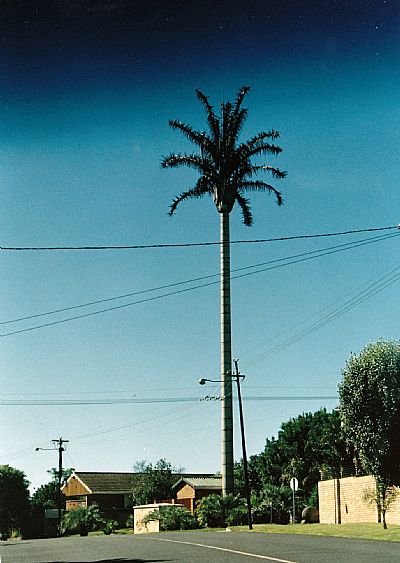
So what is a picture of a palm tree doing in a discussion on communications technology? I restarted the panel of councillors, architects and planners that considered unusual planning applications. When this came up I thought it was a joke. But it did materialise in spite of concerns about the impact on the suburb of Nahoon Mouth. This is Beach Road. The "palm tree" is in fact a communications antennae mast with the technical bits hidden amidst fronds. There were issues with some fronds falling off, but that was resolved,
Today computers play an important part in everything we do. They are integral in such things as our cars, phones and clocks. There is the concern that they rule our lives, if not literally then at least trhough making us dependent on them. Although we have not gone that far, they are available in almost everthing from the fridge to the cat-flap. EVERYTHING is after all made with them.
And although this is ME writing this and not a bot, I am using a laptop, the internet and digital archives of my own. All things unimaginable when I was young.
Foot X-ray
This is not strictly entertainment, but seems to fit in here reasonably well.
We came across such a machine at Stirling museum and that triggered memories of having new shoes fitted as a child. Many shoe shops had x-ray machines to enable customers to see the fit of shoes and possibly the state of one's feet. I think that the one that we used was at Hughes's Outfitters in Oxford Street in East London.
The shoe-fitting fluoroscope consisted of an upward-facing x-ray tube mounted inside the bottom of a metal box and a fluorescent screen at the top with three viewing ports. An opening on the side of the box allowed the customer to place his or her foot between the tube and the fluoroscopic screen. The x-rays penetrated the shoe and foot and then struck the fluorescent screen, lighting it up with the image of the customer’s foot. This image could be viewed by the customer, the salesman and another person through the three viewing ports at the same time. [Amusing Planet].
It seems that even then, the dangers of x-rays were under estimated and little understood. While to become common in medicine and security, the safety precautions were not yet fully implemented and equipment was basic. Many of us have more recently been exposed to them and the more sophisticated and safer x-ray, MRI, CT and other scans; each increasingly informative and specialist.
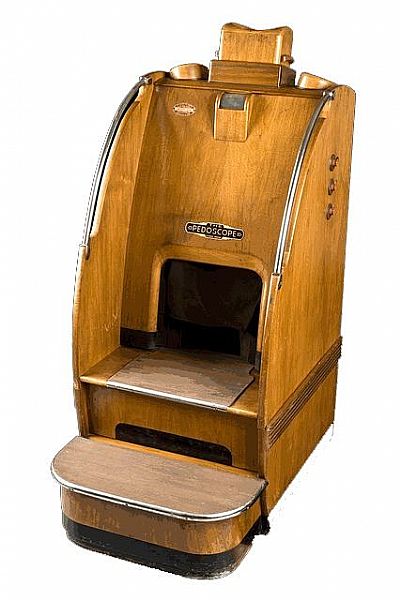
This is a Google image, but is much like the one that we used.
AMUSING PLANET : https://www.amusingplanet.com/2019/05/the-shoe-fitting-machines-that-blasted.html
CRYSTAL SET : https://www.mikeselectronicparts.com/pdf/building-a-crystal-radio.pdf
HIRSH'S blog re SA tv : https://blog.hirschs.co.za/2020/12/10/the-history-of-tv-in-south-africa/
THE INVENTORS website : https://theinventors.org/library/inventors/blcathoderaytube.htm
MOVIETONE: there is very little chance of finding that split second with me in it and even less of identifying me, but a look through their archive is fascinating. https://www.youtube.com/channel/UCHq777_waKMJw6SZdABmyaA
WIKIPEDIA crystal radio : https://www.mikeselectronicparts.com/pdf/building-a-crystal-radio.pdf
Recording cylinders : https://en.wikipedia.org/wiki/Phonograph_cylinder

